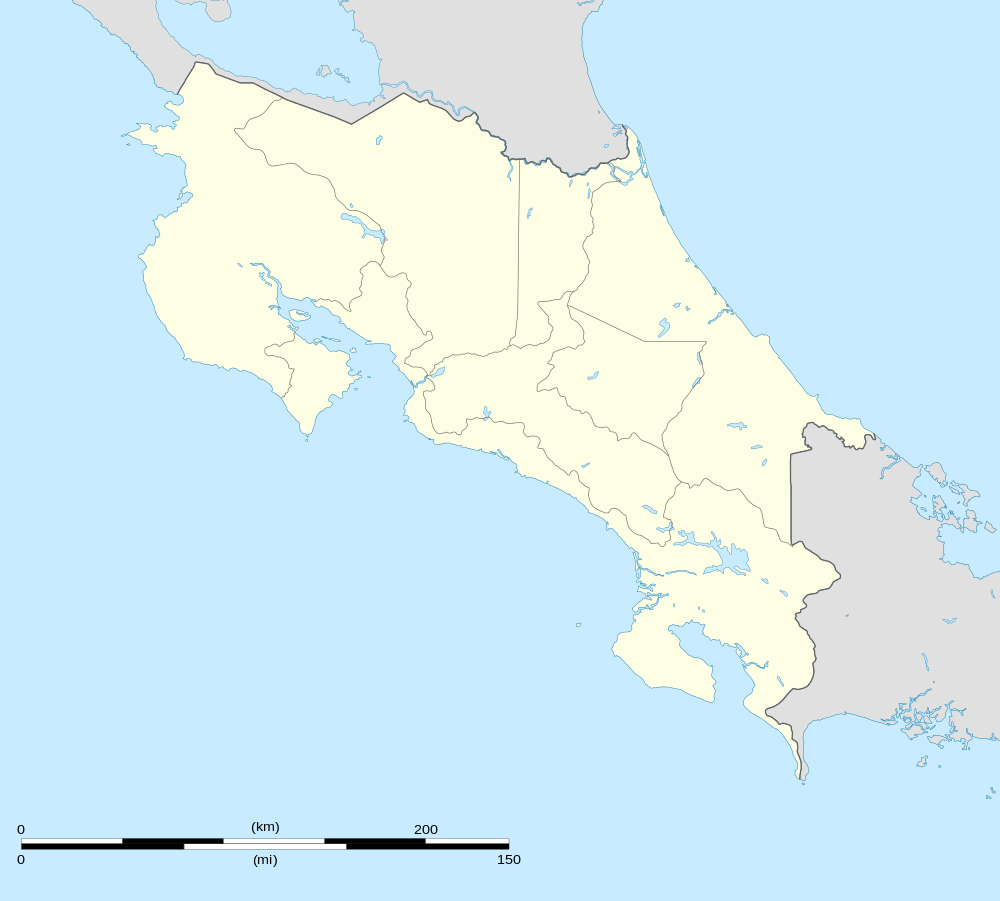Aguas Zarcas, Costa Rica
| Aguas Zarcas | |
|---|---|
| District | |
 Aguas Zarcas | |
| Coordinates: 10°12′30″N 84°20′25″W / 10.20833°N 84.34028°WCoordinates: 10°12′30″N 84°20′25″W / 10.20833°N 84.34028°W | |
| Country |
|
| Province | Alajuela |
| Canton | San Carlos |
| Area | |
| • Total | 159.04 km2 (61.41 sq mi) |
| Elevation | 100-2,100 m (−7,000 ft) |
| Population (2011) | |
| • Total | 20,239 |
| • Density | 130/km2 (330/sq mi) |
| Time zone | UTC−06:00 |
| ZIP codes | 21004 |
Aguas Zarcas is the name of the district number 4 of the canton of San Carlos , which in turn belongs to the province of Alajuela in Costa Rica.
Location
It is located in the northern region of the country. It borders the districts of Cutris to the north, La Palmera to the west, Pital and Venice to the east. While to the south it borders with the canton of Valverde Vega.
Its head, the city of Aguas Zarcas, from where it has an excellent view of the hills of the Juan Castro Blanco National Park, is located 16.6 km (30 minutes) NE of Quesada, and 88.4 km (2 hours 20 minutes) to the NW of San José the capital of the nation.
History
From 1800, Germans, Italians and Spaniards formed the ancestors of Aguas Zarcas, the same ones that founded the Spanish colony.
Its colonizers were in charge of carrying out bites in the mountain to facilitate the arrival to the inhabitants that came from Villa Quesada looking for a place where to live.
The name of Aguas Zarcas, comes from the hot spring waters that could well be called "Aguas de azul suave".
Geography
Aguas Zarcas has an area of 159.04 km², making it the eighth district of the canton by area.
It is located at an elevation of 100 to 2100 meters above sea level.
This great variation of altitude is due to the fact that in the South of the district are the mountain foothills of the Central Mountain Range, whereas in a northerly direction, the territory follows a clear descent towards the plains of San Carlos.
Demography
The district has 20, 239 inhabitants, making it the second most populated canton. Surpassing to Pital, La Fortuna and Florencia. [1]
The 17 population centers of the district are:
- Aguas Zarcas (head of the district)
- Altamira
- Caño Negro
- Cerro Cortés
- Concepción
- Coope-San Juan
- Esquipulas
- Garabito
- La Caporal
- La Gloria
- Los Chiles
- Los Lotes
- Los Angeles (Las Delicias)
- Montecristo
- Pitalito
- Santa Fe
- San Jose
Art and Sport
The district is home to one of the country's Civic Centers, which are special sports and recreational areas, promoted by the government and supported by private entities, to promote citizen coexistence through art and sport.
Culture
Every year there are popular festivals in the community, where there are mechanical games and bullfights. Also must be mentioned a kind of horse riding call El Tope, in which the riders wear their best clothes on their colorful horses.
Economy
Poultry has an important presence, with chicken farms distributed throughout the district.
Local crops of cassava and pineapple (along with citrus production from other districts) focused on exports form the basis of the local agroindustry, represented by processing plants and packing of tropical fruits and tubers.
In the city of Aguas Zarcas, there are health, educational, financial, legal, lodging, post, car repair and construction services. Entertainment services are also offered with synthetic courts, gyms, swimming pools and nightlife venues.
In terms of trade, the sale of fast foods, groceries, shoes, clothes, appliances and accessories in general stands out. Also vegetables, chicken meats and milk produced locally are brought to the center to be sold at different points of sale.
Striking sites
1-The central square has a historical Catholic church. Although, earthquakes have destroyed much of the original Spanish architecture in Alajuela, this beautiful temple still stands. With an old construction style, it is undoubtedly the most representative symbol of the community. It rises impeccably in the center of the town, dominating the urban landscape and being observable from many points of the city.
2-Within the limits of the district, there are hot springs, the biggest tourist attraction in the surroundings (shares the deposits with the neighboring district of La Palmera). These sources of heated mineral water are not related to volcanism, but to the depth of where the waters flow, along tectonic faults.
See also
- District of Quesada
- District of Florencia
- District of Buenavista
- District of Venecia
- District of Pital
- District of La Fortuna
- District of La Tigra
- District of La Palmera
- District of Venado
- District of Cutris
- District of Monterrey
- District of Pocosol
References
- ↑ "2011 Census Population Report" (pdf). INEC.